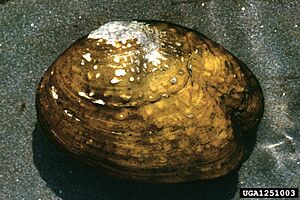Appalachian monkey-face pearly mussel facts for kids
Quick facts for kids Appalachian monkey-face pearly mussel |
|
|---|---|
 |
|
| Conservation status | |
| Scientific classification | |
| Genus: |
Theliderma
|
| Species: |
sparsa
|
| Synonyms | |
|
|
The Appalachian monkey-face pearly mussel (scientific name: Theliderma sparsa) is a special kind of freshwater mussel. It's a bivalve, which means it has two shells, like a clam. This mussel lives in rivers and belongs to the family called river mussels.
It is only found in a few rivers in western Virginia and eastern Tennessee. These areas are part of the Appalachia region in the Southeastern United States.
Sadly, this mussel is in great danger. It is critically endangered because of pollution in the rivers where it lives. The mussel eats tiny bits of food from the water. As it feeds, it can also take in harmful pollutants.
Where Does the Appalachian Monkey-face Mussel Live?
Today, only two or three groups of these mussels are left. One small group lives in the Clinch River in Virginia. Another group in the upper Powell River in Tennessee is almost gone. These groups might not be big enough to survive on their own. All other places where this mussel used to live no longer have them.
How Do Appalachian Monkey-face Mussels Reproduce?
Like many other river mussels, the Appalachian monkey-face mussel needs fish to help its babies grow. The mussel releases tiny larvae called glochidia. These larvae attach to the gills of certain fish.
Scientists have learned that the larvae can grow on the gills of blotched chub (Erimystax insignis) and streamline chub (Erimystax dissimilis). The mussels release their larvae when the water temperature is right and there is some vibration. This information comes from Tim Lane, a mussel recovery expert in Virginia.
Protecting the Appalachian Monkey-face Mussel
The Appalachian monkey-face mussel is a federally endangered species. This means the United States government has given it special protection. It gained this protection under the Endangered Species Act in 1976. This law helps protect animals and plants that are at risk of disappearing forever.


